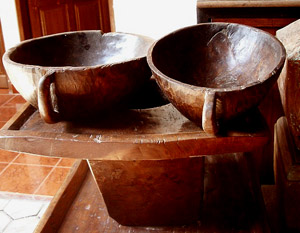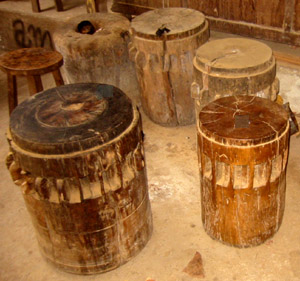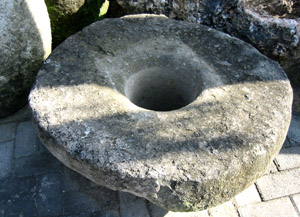 Some of the most beautiful village implements are those used in the courtyard of a family compound for grinding of corn, soybeans, or pounding of rice. The spiral teak gears of Thailand and ironwood notched gears of Indonesia are poetry in action and sculpture at rest. They gain beauty from use and wear, and eventually from disuse, as the elements of nature start to wear away their features.
Some of the most beautiful village implements are those used in the courtyard of a family compound for grinding of corn, soybeans, or pounding of rice. The spiral teak gears of Thailand and ironwood notched gears of Indonesia are poetry in action and sculpture at rest. They gain beauty from use and wear, and eventually from disuse, as the elements of nature start to wear away their features.
The corn grinders are made of a thick, sculpted, teak tray that catches the ground corn, and a pair of small hard stone discs that grind the kernels into meal. These trays, when discarded, weather as only teak can, and become sculpture a contemporary artist would be proud of having carved. The stone discs have a balance and beauty all their own.
 Rice mortars, appearing in thousands shapes and sizes, are my favorites. All the mortars saw a life of daily use, and have been left to the erosion of sun, wind, and rain, which enhanced their hand-carved beauty. The small mortars make exquisite planters, indoors or out, or they can be used as the legs of coffee tables, as visitors to the Collection will see. Medium-size mortars work as sculpture stands or end tables, if one adds a glass disc on top. They also serve as stools with cushions. Large mortars make stunning indoor or outdoor dining table pedestals, end tables, or free-standing sculpture.
Rice mortars, appearing in thousands shapes and sizes, are my favorites. All the mortars saw a life of daily use, and have been left to the erosion of sun, wind, and rain, which enhanced their hand-carved beauty. The small mortars make exquisite planters, indoors or out, or they can be used as the legs of coffee tables, as visitors to the Collection will see. Medium-size mortars work as sculpture stands or end tables, if one adds a glass disc on top. They also serve as stools with cushions. Large mortars make stunning indoor or outdoor dining table pedestals, end tables, or free-standing sculpture.
 All the mortars have a special quality and good energy that comes only from tools used in the preparation of food. They bring warmth, beauty, texture, sculptural beauty, and the richness of village life to any environment.
All the mortars have a special quality and good energy that comes only from tools used in the preparation of food. They bring warmth, beauty, texture, sculptural beauty, and the richness of village life to any environment.
![]()